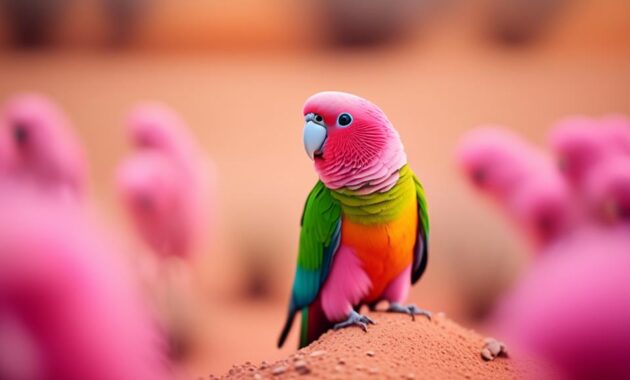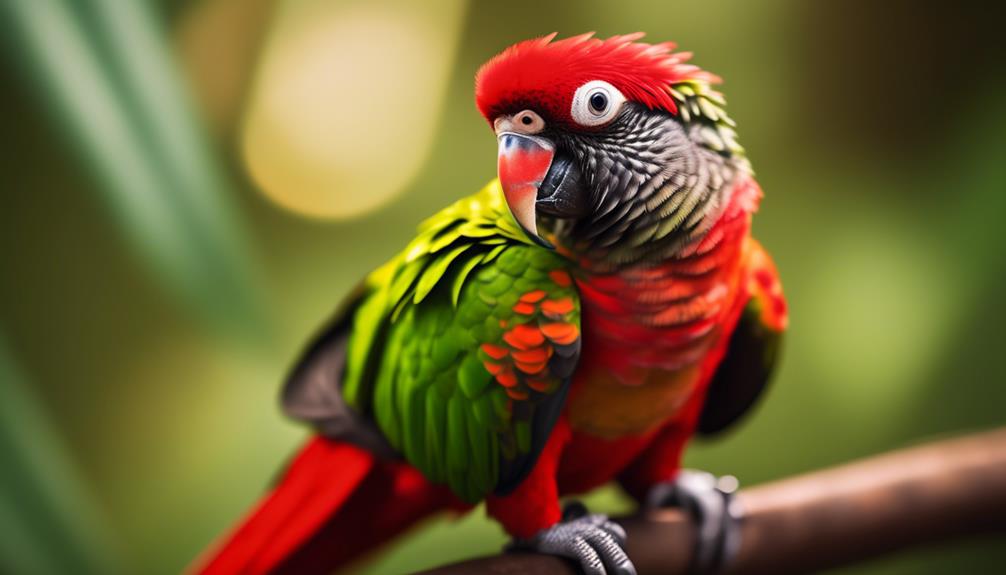
Step into a world of vibrant colors and lively personalities as you meet the Crimson Bellied Conure. This small bird, with its striking red abdomen and turquoise blue wings, is sure to capture your attention.
But there's more to these birds than just their stunning appearance. With their vocalizations and ability to mimic sounds, they are bound to keep you entertained.
So, are you ready to discover the fascinating world of the Crimson Bellied Conure and uncover the secrets of their vibrant and vocal nature?
Key Takeaways
- The Crimson Bellied Conure is a small parrot native to the Amazon Rainforest in South America, known for its vibrant green, blue, and red plumage.
- These birds have a lifespan of up to 20 years and require a spacious cage, regular vet check-ups, and social interaction for their well-being.
- The Crimson Bellied Conure's vocalizations include natural chirps and whistles, as well as the ability to mimic common sounds like alarms and whistles.
- To meet their exercise needs, these birds require a spacious and secure cage, regular flight time outside of the cage, engaging toys, and social interaction with humans or other birds.
Physical Characteristics
The Crimson Bellied Conure boasts a vibrant and striking physical appearance. These small birds have an average length of 9 inches and can weigh up to 4 ounces. Their colorful plumage is a sight to behold, with green thighs, back, and wings, turquoise blue on the lower half of their wings and upper back, and a strikingly red abdomen. Their head, neck, and chest display a unique pattern of white and grey.
To accommodate their active nature, they require a spacious cage and regular exercise. With proper care, they can live up to 20 years, making them a long-term commitment. Regular vet check-ups are essential for their well-being.
Native to the Amazon Rainforest in South America, Crimson Bellied Conures are a vulnerable breed. When it comes to vocalizations, these birds are vocal and expressive, emitting natural calls of chirps and whistles. They also enjoy making soft murmurs and chirps during playtime. While they may not be the best talkers, they can learn a few words and even mimic common sounds like alarms and whistles.
Lifespan and Care
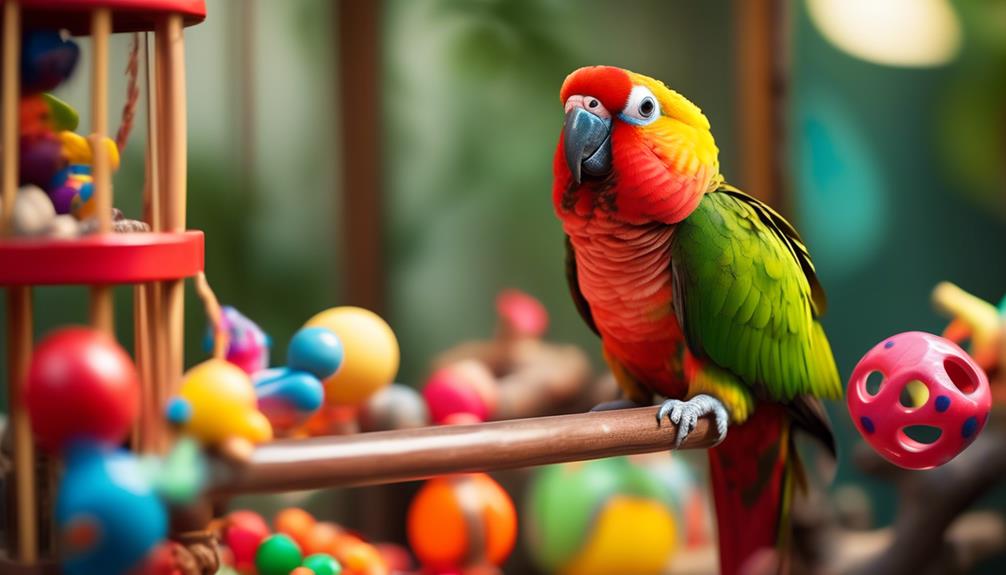
To properly care for a Crimson Bellied Conure and ensure its long lifespan, there are important factors to consider. Here are three key aspects to keep in mind:
- Provide a spacious cage: These small birds require a cage that allows them to move freely and exercise their wings. A cramped environment can lead to stress and health issues.
- Regular vet check-ups: Just like any other pet, Crimson Bellied Conures need routine visits to the vet. Regular check-ups can help identify any potential health concerns early on and ensure they receive proper care and treatment.
- Commitment and attention: These birds have a relatively long lifespan of up to 20 years. Owning a Crimson Bellied Conure requires a long-term commitment to their well-being. They thrive on social interaction, mental stimulation, and regular attention from their owners.
Bird Species and Habitat
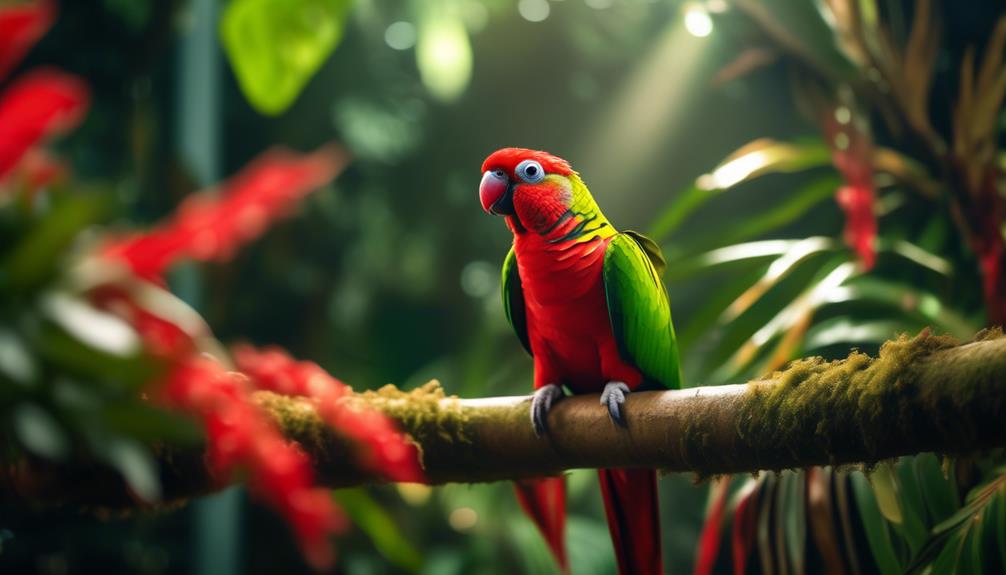
Belonging to the Conure family, Crimson Bellied Conures are a vibrant and vocal species native to the Amazon Rainforest in South America. These birds are part of the parrot species and are found in the lush environment of the Amazon Rainforest.
As a vulnerable breed, they depend on the rainforest for their survival. The dense foliage and diverse plant life provide them with a natural habitat where they can thrive. The vibrant colors of the Crimson Bellied Conures blend perfectly with the lush greenery of the rainforest, allowing them to camouflage and stay protected from predators.
Their habitat also provides them with a variety of fruits, nuts, and seeds, which make up their diet. It's crucial to preserve their natural habitat to ensure the survival of this beautiful species.
Vocalizations
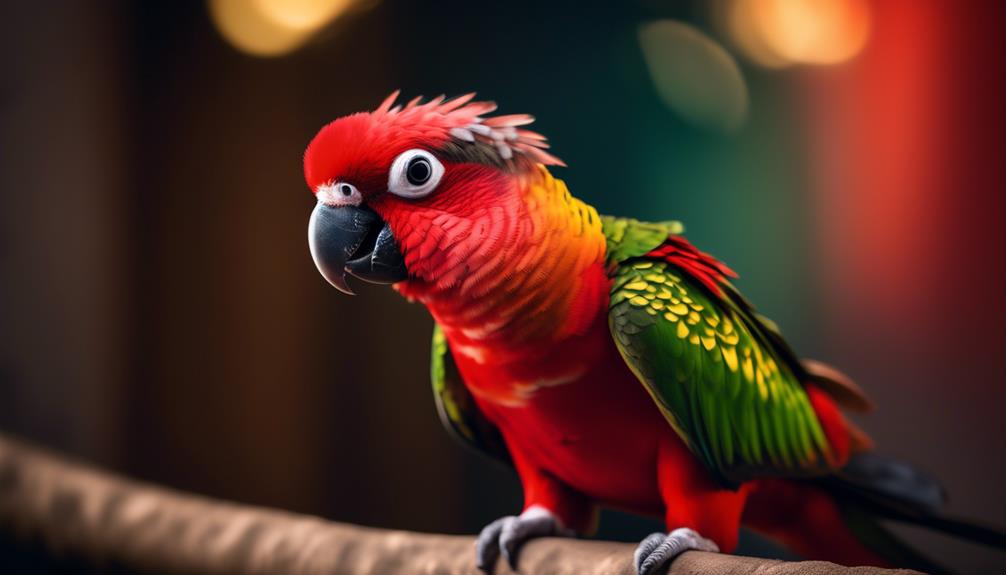
As we shift our focus to the subtopic of vocalizations, let's explore the expressive nature of the Crimson Bellied Conure. This vibrant bird has a wide range of vocalizations that showcase its lively personality. Here are three key aspects of their vocal repertoire:
- Natural calls: Crimson Bellied Conures communicate with chirps and whistles, which are their natural calls. These sounds can often be heard as they go about their daily activities.
- Playtime sounds: During playtime, these conures emit soft murmurs and chirps. This is their way of expressing happiness and enjoyment while engaging in various activities.
- Mimicking abilities: Although not the best talkers among parrots, Crimson Bellied Conures have the ability to mimic common sounds such as alarms and whistles. With patience and training, they can even learn a few words.
Cage Requirements
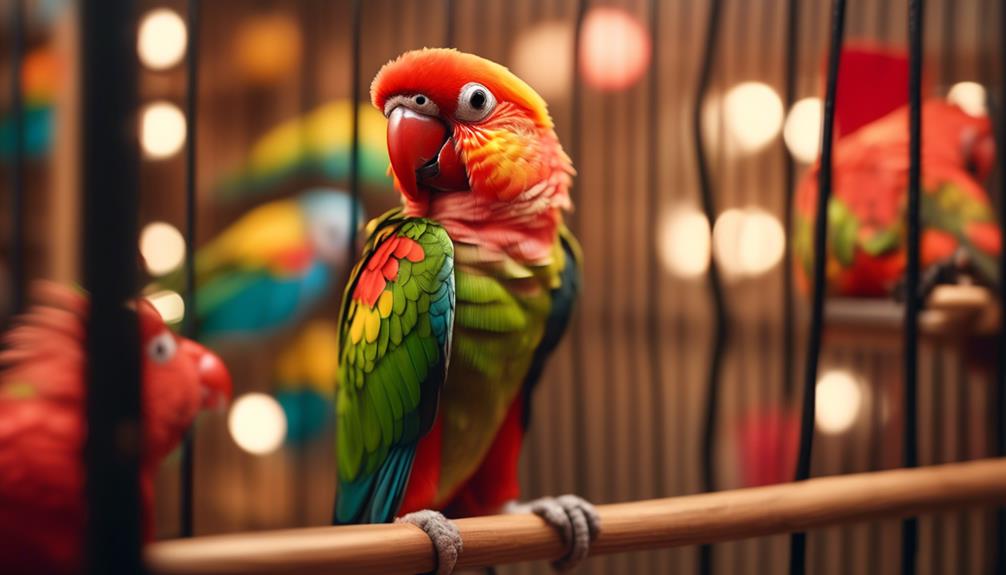
When setting up a cage for your Crimson Bellied Conure, make sure to provide a spacious and secure environment that meets their needs. These small birds require a cage that allows them to exercise and move around freely. The cage should be large enough for them to stretch their wings and hop from perch to perch. Make sure the bars of the cage are close enough together to prevent any escapes.
Provide plenty of perches of varying heights and textures to keep their feet and beaks healthy. Additionally, include toys and puzzles to keep them mentally stimulated. It's important to regularly clean and disinfect the cage to maintain a hygienic environment.
Exercise Needs
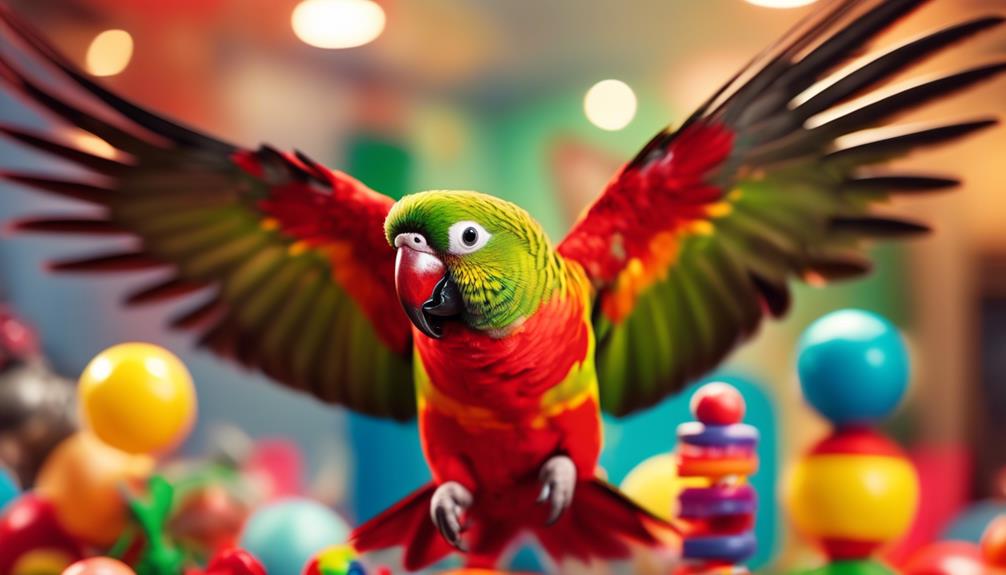
To ensure the health and vitality of your Crimson Bellied Conure, it's essential to meet their exercise needs by providing ample opportunities for physical activity. Here are three important aspects to consider:
- Regular Flight Time: Crimson Bellied Conures are active birds and require time outside of their cage to spread their wings and fly. Providing a safe, supervised environment for them to fly freely will help keep their muscles strong and their minds stimulated.
- Interactive Toys: Engaging toys are vital for an active Crimson Bellied Conure. Toys that encourage climbing, swinging, and foraging will keep them physically and mentally stimulated. Rotate their toys regularly to prevent boredom.
- Social Interaction: These conures thrive on social interaction. Regular playtime and interaction with their human companions or other bird companions will help keep them physically and emotionally healthy.
Meeting the exercise needs of your Crimson Bellied Conure won't only keep them physically fit but also contribute to their overall well-being and happiness.
Colorful Appearance
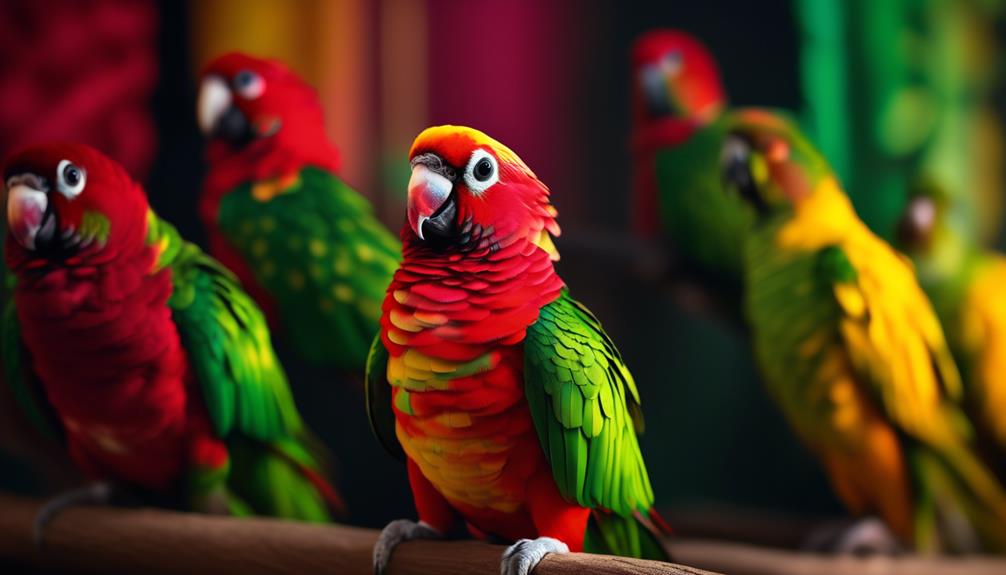
The Crimson Bellied Conure boasts a vibrant and eye-catching appearance. With its green thighs, back, and wings, turquoise blue on the lower half of its wings and upper back, and a strikingly red abdomen, this bird is truly a sight to behold. Its head, neck, and chest also feature a unique pattern of white and grey, adding to its colorful display. This beautiful conure is sure to capture the attention of anyone who sees it. Its colorful appearance is one of the reasons why it is such a popular pet bird. Whether it's perched in its spacious cage or flying around, the Crimson Bellied Conure is a stunning creature that brings joy with its vivid colors.
| Physical Characteristics | Colorful Appearance |
|---|---|
| Green thighs, back, and wings | Strikingly red abdomen |
| Turquoise blue on wings and upper back | Unique pattern of white and grey on head, neck, and chest |
Frequently Asked Questions
What Are Some Common Health Issues That Crimson Bellied Conures May Face?
Crimson Bellied Conures may face common health issues such as respiratory infections, feather plucking, and beak overgrowth. Regular vet check-ups, a balanced diet, and a clean living environment are essential for their well-being.
Are Crimson Bellied Conures Known for Their Intelligence?
Yes, crimson bellied conures are known for their intelligence. They may not be the best talkers, but they can learn a few words. Their natural calls consist of chirps and whistles.
How Do Crimson Bellied Conures Communicate With Each Other in the Wild?
Crimson Bellied Conures communicate with each other in the wild through a variety of vocalizations. They use natural calls like chirps and whistles, as well as mimic common sounds. They are expressive and can learn a few words.
What Is the Significance of the Vibrant Colors on the Crimson Bellied Conure's Plumage?
The vibrant colors on the Crimson Bellied Conure's plumage are significant because they help attract mates and establish territory. The combination of red, green, turquoise, white, and grey makes them visually striking and unique among other bird species.
Can Crimson Bellied Conures Be Trained to Perform Tricks or Tasks?
Yes, crimson bellied conures can be trained to perform tricks or tasks. With proper training and positive reinforcement, they can learn to do things like stepping up, waving, and even retrieving objects.
What Makes the Crimson Bellied Conure Unique Compared to the Bourke’s Parakeet?
The Crimson Bellied Conure is known for its vibrant red plumage, striking black head, and intelligent and playful nature, making it truly unique compared to the Bourke’s Parakeet Australia’s dazzling, which is known for its peaceful and gentle demeanor, and subdued pink and blue coloration.
Conclusion
So, if you're looking for a bird that will bring beauty and joy to your life, look no further than the Crimson Bellied Conure.
With its vibrant colors and expressive nature, this small yet captivating bird is a sight to behold.
Not only are they visually stunning, but their vocalizations and ability to mimic sounds will keep you entertained for hours.
With proper care and a suitable habitat, these vibrant and vocal creatures can bring a world of happiness into your home.



